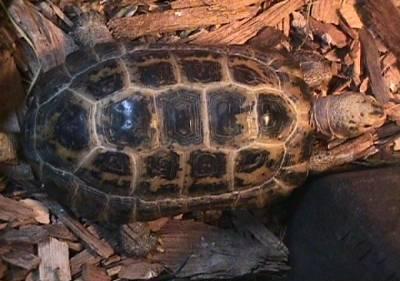Forsten's Tortoise
Forstens Tortoise, Celebes Tortoise, Travancore Tortoise Scientific Name: Indotestudo forstenii
Sun, 15th June, 2025 - 7:02 am GMT
Sponsor Ads:

Alternative Name
Forstens Tortoise, Celebes Tortoise, Travancore Tortoise Scientific Name: Indotestudo forsteniiBasic Info
Forsten's Tortoises are quite similar in appearance to Elongated Tortoises. However, most, though not all, Forsten's Tortoises do not have a nuchal scute. Also, there tends to be less black coloration on the plastron of Forsten's Tortoises than on those of Elongated Tortoises. Their carapaces are elongated and rather narrow. The heads are yellow or yellowish orange, as are the carapaces. Often the carapace is marked by black or brown blotches in the center of each scute. Most Forsten's Tortoises grow to about a foot in length.
Health
Forsten's tortoises can be very difficult to care for in captivity if they are wild-caught. Most imports are in very poor shape and the mortality can be over 70 percent. Those that survive often are often extremely parasitized and unless the "average" tortoise owner has extensive veterinary skills and access to cutting-edge medications, he or she will often lose most or all of the imported tortoises. Young animals tend to be in better shape. Once a stable group has been established (this may be rather expensive), the animals are very territorial and it is not unusual for females to take bites out of each other's legs. Males can be very aggressive and also bite, causing injury. Forsten's Tortoises require large enclosures. Usually a land area in addition to a shallow bowl, tub, or pond is appropriate. It is important that Forsten's Tortoises be allowed some opportunity to soak. The enclosure should have an area of substrate that is kept moist at all times and a drier floor area. Sphagnum moss or orchid bark work well for maintaining high humidity levels. Full spectrum lighting should be available during the day, but there should be places where the tortoise can get out of direct light. The ambient daytime temperatures for Forsten's Tortoise should be about 80 - 82 degrees Fahrenheit, and a basking spot between 85 and 90 degrees Fahrenheit should be provided. Some Forsten's Tortoises use their basking areas often, but many use them little or not at all. At night, 65 -70 degrees Fahrenheit is appropriate. Often, winter is simulated by dropping daytime temperatures to 75 degrees Fahrenheit (24 degrees Celsius) during the day. Forsten's Tortoises do not hibernate. Breeding Male Forsten's Tortoises have concave plastrons and longer tails than females. Usually, breeding can be encouraged by regularly spraying Forsten's Tortoises with warm water. In the wild, breeding takes place during the beginning of the rainy season.Habitat
Live in humid forests at higher elevationsBehavior
Forsten's Tortoise, a remarkably species, is not very well known in many countries. These beautiful tortoises can be a joy to keep, though they may be an ordeal to acquire. In the wild, Forsten's Tortoises usually live in humid forests at higher elevations. During very hot seasons, they may emerge into more open areas to bask. They scavenge on the ground for fallen fruit, which makes up a large part of their diet. Forsten's Tortoises are crepuscular, meaning they move most often in the morning and evening hours. Usually, Forsten's Tortoises are most active in the early part of the rainy season. They appear to be most energetic right after a warm heavy rain. In captivity, they are often quite secretive. They seem to enjoy soaking in water and will often rest partially submerged for hours, provided the water offered to them is warm.Origin
Indo-PacificHistory
Although Forsten's Tortoises are present in Sulawesi, it is believed that that population was introduced. It is believed that all Forsten's Tortoises originated from India and Indonesia. They are listed under CITES Appendix II as rare animals.Common Foods
In captivity, Forsten's Tortoises should be fed a diet rich in fruits and vegetables. Many seem to prefer yellow foods like squash and corn. They should be offered a higher percentage of fruit in their diets than many tortoises. Earthworms, snails, waxwSponsor Ads:
Thoughts on Programming, Number 29: Cost does indeed vary as the product of the number of men and the number of months. Progress does not. Hence the man-month as a unit for measuring the size of a job is a dangerous and deceptive myth. -The Mythical Man-Month Frederick P. Brooks, Jr.
Forsten's Tortoise
Coded by: BGID® | ALL RIGHTS RESERVED Copyright © 2000-2025
Disclaimer | Privacy | Report Errors / Contact | Credits








 President of the United States of America - Real Estate mogul, Pageant owner and now one of the most controversial men in political history.
President of the United States of America - Real Estate mogul, Pageant owner and now one of the most controversial men in political history.  Global warming has been in and out as the "latest" hot topic for many years. It is, according to modern scientists, the result of man-made industrial pollutants, clearing forested areas, agriculture, etc. But now they are thinking it started way before the Industrial Revolution...
Global warming has been in and out as the "latest" hot topic for many years. It is, according to modern scientists, the result of man-made industrial pollutants, clearing forested areas, agriculture, etc. But now they are thinking it started way before the Industrial Revolution...  Politician, US Vice President and President of the USA - Joseph Robinette Biden Jr.
Politician, US Vice President and President of the USA - Joseph Robinette Biden Jr.  versus
versus  Russia: 'The Evil Empire'? Are they all that bad or is it just the USA trying to portray Russia as bad because they are a world power with land bigger and a society very different from the USA ideal?
Russia: 'The Evil Empire'? Are they all that bad or is it just the USA trying to portray Russia as bad because they are a world power with land bigger and a society very different from the USA ideal? 
 Corona virus
Corona virus 
 Users with wide screen monitors can benefit from more content on every page.
Users with wide screen monitors can benefit from more content on every page.